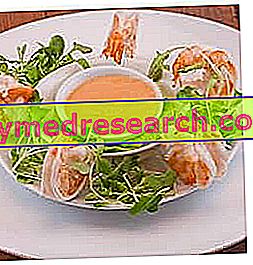What is that
The pink sauce or cocktail sauce is a cold seasoning to combine with various dishes; the most common pairings are those with fish, molluscs, crustaceans, certain fried foods and sandwiches of various kinds (especially those stuffed with cooked ham, shoulder, roast turkey or chicken, roast - veal beef, frankfurters etc.).

The pink sauce is composed of a few ingredients (5 or 6) to be mixed in the right doses. At first glance, the cocktail sauce would seem a simple and quick preparation to perform. Indeed, following a very precise recipe, the composition of the pink sauce is rather elementary; however, what should NOT be left to chance is the choice of the right ingredients; this choice, in fact, must be carefully weighted ACCORDING TO THE FOOD WITH WHICH it will be associated.
Basic recipe
Below we will illustrate the basic version for the pink sauce or cocktail sauce.
Ingredients
Ingredients for 280 or 365g of pink sauce or cocktail sauce:
- Mayonnaise 150-200g,
- Ketchup 50-65g,
- Cream (fresh, to be whipped, not sweetened), 20-25g,
- Mustard sauce 15-20g,
- Cognac 35-45ml,
- Worcestershire sauce ≥10g.
Note
- Some variations affect the mayonnaise, eventually replaced with light mayonnaise or yogurt, and fresh cream, instead replaced by Greek yogurt.
- It is quite important to use COLD ingredients and not at room temperature; in this way it is possible to instantly check the density of the food.
Method
If you choose to use fresh cream, first whip the cream; then, in a bowl, combine mayonnaise and ketchup, worcestershire sauce, cognac, mustard sauce and whipped cream (or Greek yogurt). Mix without removing the cream and heat the sauce. Allow to cool in the refrigerator.
Video Recipe
Rose Sauce or Cocktail Sauce
X Problems with video playback? Reload from YouTube Go to Video Page Go to Video Recipes Section Watch the video on youtubevariants
Variations of the pink sauce or cocktail sauce and implications
The percentage variation of one or the other ingredient involves different changes in the food; among these we mention: taste, consistency, nutritional intake and shelf life.
- First of all, using ONLY "packaged" ingredients, thanks to the presence of food additives (preservatives and antioxidants), the maintenance times of the rose sauce increase compared to the totally homemade one. Even the use of cognac, worcestershire and mustard have a positive effect on the shelf-life of rose sauce, although an excess of alcohol and sodium, in addition to making the preparation less pleasant, would compromise the nutritional balance of the meal.
- The nutritional contribution of the cocktail sauce varies mainly according to the type of mayonnaise and the type of dairy product used; if the mayonnaise is light or yogurt (see the recipe: Light mayonnaise and yogurt mayonnaise), and if Greek yogurt is favored over fresh cream, the intake of fat and total calories will be decidedly lower than the recipe traditional. NB . The use of light mayonnaise without oil is, from a practical point of view, more problematic than the others (stability, emulsion, etc.).
- As for the consistency of the pink sauce, it increases or decreases according to the temperature (due to the physical characteristics of saturated fats) and based on the concentration of water and / or alcohol and / or fat and / or protein . Increasing the liquid components such as cognac and worcestershire gives the rose sauce greater fluidity; the same happens using homemade mayonnaise (which, being free of additives, is always more fluid) and / or homemade ketchup (or of a brand that produces it less consistent than the others). Greek yoghurt, despite being more protein than whipped cream, is also less fat, which is why it has a lower thickening capacity than whipped cream. However, let us remember that by fitting the latter fully, a certain difficulty could occur in the homogenization of the compound without disassembling it.
 | ||||||||||||||||||||||||||||||||||||||||||||||||||||||||||||||||||||||||||||||||||||||||||||||||||||||||||||||||||||||||||||||||||||||||||||
Nutritional values (per 100 g of edible portion) | ||||||||||||||||||||||||||||||||||||||||||||||||||||||||||||||||||||||||||||||||||||||||||||||||||||||||||||||||||||||||||||||||||||||||||||
| ||||||||||||||||||||||||||||||||||||||||||||||||||||||||||||||||||||||||||||||||||||||||||||||||||||||||||||||||||||||||||||||||||||||||||||
The taste, therefore the balance between sweet, salty, acid and spicy of the cocktail sauce, must be managed according to the foods that will enjoy the respective accompaniment; a delicate product is more suitable for white fish, while a more decisive condiment better meets the organoleptic needs of meat preparations and salami sandwiches (eg. Panettone Gastronomico). The taste regulation must however respect the consistency parameter and all the characteristics (taste, consistency, nutritional contribution and shelf life) must be in perfect reciprocal balance.
Nutritional characteristics
Let's start by pointing out that the pink sauce is NOT a food suitable for children, since it contains (albeit in modest quantities) ethyl alcohol; this is not attributable to any metabolic compromises, but to the sensory education of the young subjects. Accustoming them to the taste of ethyl alcohol (also contained in certain snacks and other packaged foods) means increasing the chances that they will use them in adulthood or adolescence.
TRADITIONAL cocktail sauce is a very energetic condiment. The percentage of lipids, deriving above all from mayonnaise and fresh cream, is high but the distribution of fatty acids is in favor of unsaturated (thanks to the massive presence of vegetable oil, always in mayonnaise). There is no detailed information on cholesterol but it is conceivable that, due to the presence of egg yolks in mayonnaise, it is quite high. Proteins are few but essentially of high biological value; the fiber is deficient and the carbohydrates do not exceed, even if mainly deriving from the sucrose of ketchup. The cocktail sauce is not a food suitable for those who suffer from overweight or metabolic diseases.
Among the minerals good concentrations of desirable elements are not observed, while the sodium intake is considerable (to the disadvantage of those suffering from arterial hypertension).
Vitamins include a good content of niacin (vit. PP) and antioxidants (probably added for preservation) type A, C and E.



